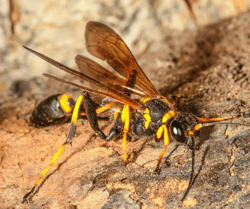Mud daubers are large wasps with uniquely slender, angular abdomens that make them look straight out of a sci-fi film. They are unmistakable in appearance and easily one of the more intimidating-looking wasp species. For those with a particular fear of stinging insects, encountering a mud dauber may feel like a bad dream come true. But much like many things in nature, an alarming appearance does not always equate to a dangerous creature. And so we’re left with arguably the most pertinent question of all: do mud daubers sting people?
What are mud daubers?
But first – what even are “mud daubers”?
Mud dauber wasps are a group of solitary wasps that build their nests out of mud, hence their name. There are many different species of mud daubers, but they all share certain characteristics regarding their biology and behavior. Mud daubers are relatively common in the United States but are native to the meadows of Canada. It’s theorized that they first appeared in the West Indies before spreading throughout most of North America.
They are typically slender wasps with a thread-like waist and long legs. They can range in size from about ½ inch to 1 inch in length, depending on the species. They are usually black or metallic blue in color and may have yellow or white markings on their bodies.
Mud daubers are important predators of spiders, which are caught and paralyzed with their stingers. They are particularly adept at catching black widow spiders, which are toxic to many other predators. Mud daubers are also known for their precise nest-building behavior. They use their mandibles to shape small balls of mud into tubes, which they then arrange in a nested structure.
Mud daubers have a relatively simple life cycle. Females construct their nests out of mud, which they collect from damp soil or from nearby water sources. The nest consists of a series of cylindrical tubes (often referred to as “cells”) each of which is filled with paralyzed spiders and a single egg. Once the egg hatches, the larva feeds on the spiders before pupating and emerging as an adult wasp.
Unlike most bee species, mud daubers are considered to be solitary wasps and do not form colonies like many other species. Mud daubers are generally active during the day and are often seen flying around gardens, parks, and other areas where spiders are abundant. They may also be attracted to areas with plentiful mud, such as water sources or areas with damp soil.
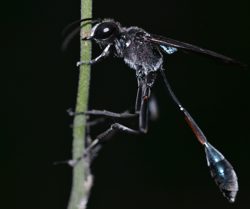 Mud daubers can range in color but black or metallic blue are common.
Mud daubers can range in color but black or metallic blue are common.
Are mud daubers dangerous?
Mud daubers are generally not considered to be dangerous to humans, pets, or property. Because they are solitary wasps, they lack the inherent need to protect their colony and queen. Mud daubers are not aggressive by nature and are unlikely to sting unless they are provoked. They may attempt to attack if they feel you are threatening them or their nest, however.
Unlike some other wasp species, mud daubers do not form large colonies and are not territorial. They are generally non-hostile and will only sting if they feel threatened or are provoked. Mud dauber stings are incredibly uncommon. In addition, their venom is not very potent and is not likely to cause a severe reaction in most people or pets. That said, allergic reactions may occur in rare cases.
Mud daubers are also very unlikely to cause damage to property. Their mud nests are relatively small and are not known to cause structural damage. However, their nests can be unsightly and may need to be removed if they are in a location that is causing problems. In addition, abandoned mud dauber nests have been known to be infiltrated by other wasp species that may be more aggressive in nature. For example, paper wasps have been known to take over abandoned mud dauber nests and use them as a starting point for their own nests. Other types of wasps may also use the abandoned nests for shelter or as a place to store food.
Overall, while mud daubers may be a nuisance in some cases, they are generally not dangerous to humans, pets, or property. In fact, they are beneficial to have around because they are important predators of spiders, which can be a nuisance in their own right.
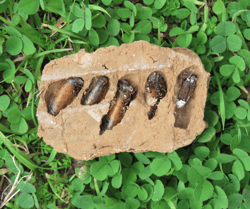 Abandoned mud dauber nest removed from site.
Abandoned mud dauber nest removed from site.
Where do mud daubers build their nests?
Mud daubers build their nests in a variety of locations, but they typically choose protected areas that are sheltered from the elements and offer some degree of privacy. Here are some common locations where mud daubers may build their nests:
- Under eaves: Mud daubers often build nests on the underside of eaves or other overhangs. These areas offer protection from rain and other elements and are often shaded, which can help to keep the nest cool.
- In crevices: Mud daubers may also build their nests in small crevices, such as in between bricks or in the joints of window frames. These locations offer protection and privacy, and can be difficult for predators to access.
- On walls: Mud daubers may construct their nests directly on walls, particularly if the wall is made of a porous material such as bricks, adobe, or stucco. The rough texture of the wall can make it easier for the mud to adhere to the surface.
- In attics or crawl spaces: Mud daubers may build their nests in attics or crawl spaces, particularly if there is access to the outside through vents or other openings. These areas offer protection and privacy and may be less likely to be disturbed by humans.
Overall, mud daubers are adaptable insects that can build their nests in a wide range of locations. If your property has a pond, river, lake, or even just ample access to moist soil and mud, you may be more likely to encounter mud daubers.
.png?width=250&height=188&name=MicrosoftTeams-image%20(58).png) Mud dauber nest on brick exterior.
Mud dauber nest on brick exterior.
How can I identify a mud dauber nest?
Mud dauber nests are fairly easy to identify once you know what to look for. Here are some characteristics to help you identify a mud dauber nest.
- Size: Mud dauber nests are typically small, with a diameter of just 1-2 inches. They are usually cylindrical or oblong in shape and may be somewhat flattened on one side if the nest is attached to a vertical surface.
- Shape: Mud dauber nests are made of mud, which gives them a distinctive appearance. They may have a smooth, polished surface or a rough texture, depending on the type of mud that was used.
- Location: Mud dauber nests are usually found in protected areas, such as under eaves, crevices, or walls. They may be located near a source of mud, such as a mud puddle or damp soil.
- Openings: Mud dauber nests have a single, narrow opening through which the adult wasp enters and exits. The opening may be located at the top or bottom of the nest, depending on the orientation of the nest.
- Contents: Mud dauber nests may contain one or more cells, each of which contains a single wasp egg and a paralyzed spider. If you can see inside the nest, you may be able to see the spider (or spiders) inside.
It's important to note that mud dauber nests may be confused with the nests of other types of wasps, such as paper wasps or yellow jackets. However, mud dauber nests are usually smaller and have a distinctively different appearance due to their smooth or rough texture. If you are unsure what type of nest you have, it's best to contact a pest control professional like EcoShield for assistance. Incorrectly identifying a mud dauber’s nest may leave you and your family susceptible to potential danger or property damage.
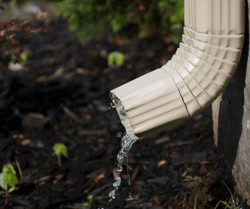 Downspouts with poor drainage that results in wet soil and mud can attract mud daubers to your home.
Downspouts with poor drainage that results in wet soil and mud can attract mud daubers to your home.
Can I prevent mud daubers?
Preventing mud daubers from building nests around your home can be tricky due to a variety of factors. If you reside in an area with an abundance of spiders and mud, it’s only natural that mud daubers will be attracted to your home and property. That said, there are a few ways you may be able to make your home less hospitable to a mud dauber, such as:
- Keep your property clean: Mud daubers are attracted to areas with an abundance of spiders, which they use as food for their young. Keeping your property clean and free of debris can help to reduce the number of spiders on your property, which in turn can reduce the number of mud daubers.
- Seal up cracks and crevices: Mud daubers like to build their nests in protected areas such as under eaves, in crevices, or on walls. Sealing up any cracks or crevices in your home or other structures on your property can help to prevent mud daubers from building nests. A reputable pest control professional may be able to help you identify potential problem areas and recommend solutions to dissuade mud daubers from building nests.
- Remove existing nests: If you find mud dauber nests on your property, it's important to remove them as soon as possible. This will prevent new wasps from hatching and building new nests in the same location. Please keep in mind that it may be difficult to tell if an existing nest is currently inhabited by either a mud dauber or another wasp species. While mud daubers are not hostile by nature, they may sting if you attempt to remove their nest while they are inhabiting it. In addition, abandoned mud dauber nests are often adopted by other wasp species and can be much more aggressive and resistant to removal attempts. It is always recommended that you contact an expert for nest removal to prevent any potential injuries or stings.
- Use a residual insecticide: Applying a residual insecticide to areas where mud daubers are likely to build nests, such as under eaves or in crevices, can help to deter the wasps from nesting in these locations. It’s important to thoroughly research any insecticide used to ensure it is both safe to use and applied correctly. If you have children or pets, we recommend you contact a people-and-pet friendly pest professional to handle the selection and application of insecticides.
- Install insect screens: Installing insect screens over vents, windows, and other openings can help to prevent mud daubers from entering your home or other structures on your property.
If you are concerned about mud daubers on your property, it's best to contact a pest control professional for assistance. In some cases, leaving mud daubers alone entirely may be the best course of action due to their non-aggressive behavior and non-invasive nesting habits. A reputable pest professional will be able to advise you on the best course of action for both preventing nests and removing existing nests.
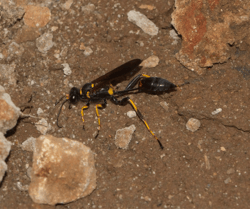
What should I do if I find a mud dauber’s nest on my property?
If you find what you believe to be a mud dauber’s nest on your property, don’t panic. Mud daubers generally avoid humans when possible and do not cause any significant damage to your home or property. If the nest is out of reach of children and away from highly trafficked areas of your home or yard, it may be best to leave the nest and mud dauber alone altogether. Many homeowners can go months without even realizing a mud dauber has taken up residence on their property due to their solitary nature and preference to keep distance between themselves and humans. Essentially, if the mud dauber’s nest isn’t actively a problem, then there’s no need to make it one.
However, mud daubers will occasionally build nests in areas that are not ideal for homeowners. In these instances, removal may be your best course of action. As a reminder, whether a mud dauber lives in the nest or if it has been adopted by another wasp species, removing the nest yourself can put you at risk of being stung. Due to the inherent risk, we highly recommend you contact a pest control professional to remove the nest safely.
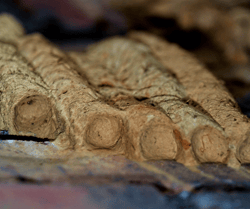 Mud dauber nest and cells.
Mud dauber nest and cells.
Does EcoShield prevent or remove mud daubers?
Yes!
EcoShield’s Home Protection Plan helps prevent mud daubers from building nests in or around your home. Monthly or quarterly pest control service with EcoShield can not only assist in keeping mud daubers away from your home, but also catch any potential problem areas in or around your home that may be ideal mud dauber nesting sites. If you have experienced issues with mud daubers in the past, our expert technicians can also customize a prevention plan to decrease the likelihood of their return.
Give EcoShield a call or fill out the form on this page to protect your home against mud daubers and other pests today!
